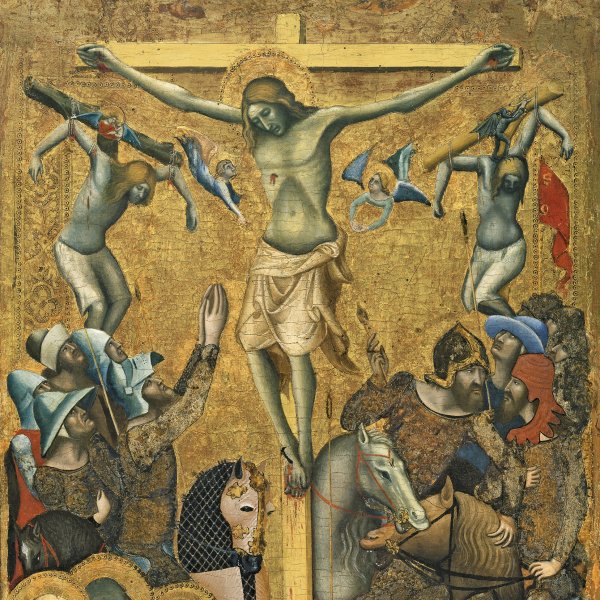Vitale da Bologna
(?), before 1309-(?) between 1359/61
Vitale da Bologna, whose real name was Vidalino di Aymo de Equis, was probably born in Bologna around 1300. During his training he must have assimilated the Bolognese Gothic style, of which he is the leading exponent. The first reference to his activities dates from 1330 when he received a payment for the decoration of a chapel in San Francesco in Bologna.
Vitale da Bologna’s early works reveal the influence of the Rimini school with regard to iconography, the gestures of the figures and the use of a colour range based on olive green and dark red tones. However, his style evolved and became more complex and expressive, reflecting the influence of Giotto in the architectural settings, perspective and vitality of the figures. This is evident in The Last Supper (Pinacoteca Nazionale, Bologna) of 1340. Vitale da Bologna’s work was also influenced by the work of the Bolognese manuscript illuminators. The decorative richness of his style indicates that he was familiar with the work of Simone Martini, and with that of Pietro Lorenzetti in the drama of the faces.
Among Vitale’s most notable works are the panels painted for the Oratory of the Virgin at Mezzaratta, Bologna, including La Madonna dei Denti, which is signed and dated 1345, and the frescoes in Santa Apollonia in Mezzaratta (now Pinacoteca Nazionale, Bologna). In 1349 Vitale painted frescoes for the presbytery of Udine cathedral (now lost). One year later he returned to Bologna and in 1351 executed a cycle of frescoes for the abbey at Pomposa on The Life of Saint Eustace.
Vitale’s style combines different influences and looks forward to late 14thcentury Gothic, opening the way for subsequent generations of Bolognese painters. His most talented pupil, Tommaso da Modena, developed his iconographic and technical innovations, while Andrea da Bologna and Cristoforo di Jacopo Biondi continued to work in his style in Bologna.
Vitale da Bologna’s early works reveal the influence of the Rimini school with regard to iconography, the gestures of the figures and the use of a colour range based on olive green and dark red tones. However, his style evolved and became more complex and expressive, reflecting the influence of Giotto in the architectural settings, perspective and vitality of the figures. This is evident in The Last Supper (Pinacoteca Nazionale, Bologna) of 1340. Vitale da Bologna’s work was also influenced by the work of the Bolognese manuscript illuminators. The decorative richness of his style indicates that he was familiar with the work of Simone Martini, and with that of Pietro Lorenzetti in the drama of the faces.
Among Vitale’s most notable works are the panels painted for the Oratory of the Virgin at Mezzaratta, Bologna, including La Madonna dei Denti, which is signed and dated 1345, and the frescoes in Santa Apollonia in Mezzaratta (now Pinacoteca Nazionale, Bologna). In 1349 Vitale painted frescoes for the presbytery of Udine cathedral (now lost). One year later he returned to Bologna and in 1351 executed a cycle of frescoes for the abbey at Pomposa on The Life of Saint Eustace.
Vitale’s style combines different influences and looks forward to late 14thcentury Gothic, opening the way for subsequent generations of Bolognese painters. His most talented pupil, Tommaso da Modena, developed his iconographic and technical innovations, while Andrea da Bologna and Cristoforo di Jacopo Biondi continued to work in his style in Bologna.




